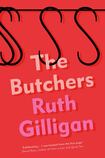
Early spring and a mysterious, swiftly spreading virus takes hold in England. In Ireland, fears of cross-contamination and wild rumours as to its cause abound in a country gripped by impending political and economic change.
The Butchers, Ruth Gilligan’s pacy and evocative fifth novel, is set, not in 2020, but in 1996, although inevitably some parallels seem uncanny, reading it at a time of a pandemic and resulting societal upheaval.
The virus is BSE, imported from British cattle. Politically, the Northern Irish peace process has broken down after 18 months of ceasefire; the Belfast Agreement is still two years away. In the Republic, society is changing, slowly: homosexuality stopped being illegal in 1993; in 1995 the Constitution was amended to allow spouses to divorce.
All of these factors come into play in the two Border region counties in which Gilligan sets the book – Cavan and Monaghan - and in the interlinking narratives of two families and one outsider.
Úna is nearly 13, a secretive, anxious adolescent who is isolated with her mother Grá at their home in Cavan for most of the year as her father, Cúch, is part of a ancient traditional group known as “The Butchers”, eight men who travel the country killing cattle respectfully, ritualistically, by hand: the old methods, rooted in Irish folklore, for farmers who are still “believers”. Modern technology and general suspicion threatens this way of working; as does the increasing export of fast-food culture from the US. Úna is ostracised at school and nicknamed “cowgirl” by her classmates: in one nasty passage a gang attempts to force feed her a McDonald’s burger. Úna, who has a freezer full of carefully dismembered cold cuts of beef at home, is violently sick. Grá, also mistrusted by the community, bored, lonely and sexually frustrated, ekes out the duration of Cúch’s long absences; her only friend is their older neighbour, Mrs P, whose husband Sol is also one of the Butchers.
Local kingpin
Nearby in Monaghan, Fionn Macready, a farmer with a dodgy past, is desperate to supplement his income. His wife, Eileen, has a brain tumour: he has heard of a private clinic in Dublin which may be their last chance. Unwisely, he takes on dangerous, well-paid work linked to a local kingpin known as The Bull – smuggling banned British cattle over the Border for sale in the Republic. Fionn is treated with contempt by his son, Davey: diffident, dreamy and obsessed with Greek and Roman mythology, Davey is about to sit his Leaving Cert exams, escape the farm and his “meathead” contemporaries, and head to university.
Hovering around the periphery of both families is Ronan Monks, a young photographer dubiously searching for elusive success. Over two decades later, in New York, Ronan, now a household name, will face an unanticipated reckoning over one of his most prized “killer shots” , never before revealed to the public: that of a dead man hung upside down by his feet in a dank Irish storehouse, otherwise empty save for a picture of the Virgin Mary on the wall.
This image is central to the book and its terrible dark heart. Honour and corruption – the grave solemnity of The Butchers versus the smooth lies of The Bull and sly thuggishness of his henchman – constantly run up against each other : a well-realised symbol of the confrontation between old and new Ireland.
Fear and menace
Gilligan’s backdrop of heart-stopping rural beauty and changing seasons – the remote lake where Grá swims daily, the comfort of Fionn’s cow byre and his favourites among the cattle, known as “the girls” – is laced with fear and menace: the rope which swings like a noose in Fionn’s farmyard; the black weeds in the water which threaten to drag Grá down into the depths. Úna is a singular and at times unnerving creation: questioning her identity, she is also a girl reluctant to grow up, binding her developing breasts and cutting her long hair, with a morbid fascination for The Butchers’ practices: and yet Gilligan rightly uses her to question misogyny and custom. Similarly Davey, who faces up to his own burgeoning sexuality in a brief romance with Con, one of the younger Butchers, also becomes an agent for change.
Gilligan is a master plotter, although there is a forced resolution to some of the back stories – Grá’s long-lost sister; the true fate of the dead man in the photograph. Filial attachment is sweetly rendered – between Davey and Eileen, Úna and Grá – and its counterpart, distance: achingly so in the case of Fionn and Davey, in one of the novel’s affecting final chapters.










